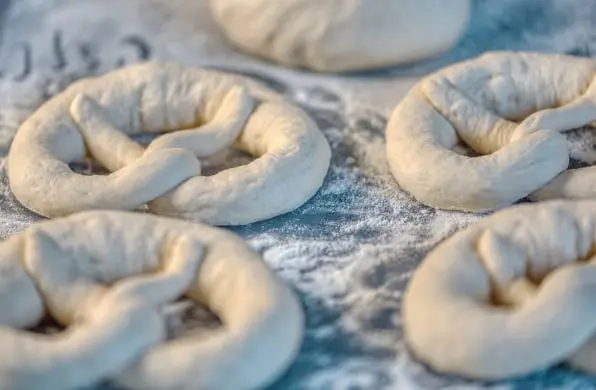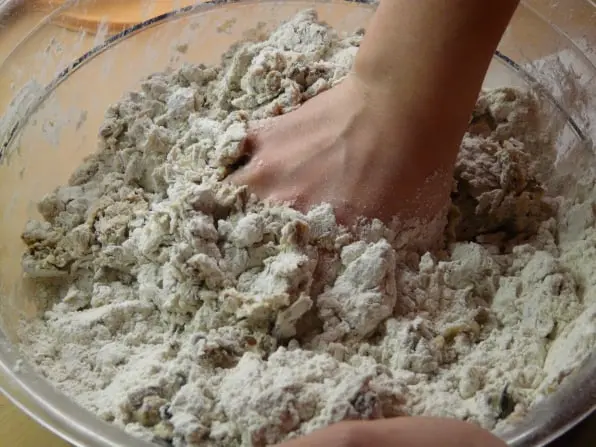Bread Traceability app:
Bread Traceability app for bread manufacturer, bakers, bakery, bread retail and wholesale. Full bread quality management solution.

Bread Supplier Traceability & management
Bakery product traceability is a huge priority for any wholesale, retail or commissary bakery. You never know when you’ll need to do a recall or collect data for an audit. Being as busy as you are, you’ll want your bakery product traceability to be as quick and easy as possible. With FlexiBake, you can keep track of your inventory from start to finish – and perform recalls in under 30 seconds!
Bakery Product Traceability Starts with Inventory Management
FlexiBake has many key features that help make bakery product traceability a breeze. The beginning of the process starts at your Raw Material inventory. You can record fresh lot numbers as they arrive at your receiving bay. From there, these lot numbers will be consumed through production into recipes, sub recipes, or products! You will also be able to adjust these lot numbers on the fly. If you drop a bag of flour, you can quickly submit an Inventory Adjustment so the system knows exactly what is available to use.
First in, First out for Bakery Product Traceability
As your initial ingredients get turned into recipes and products, FlexiBake assigns available ingredient inventory to these new items. There are a few choices on how this is done, depending on your style and specific business, but all options include an automation button which uses the first in, first out method. FlexiBake’s auto-generate tools make your day to day workflow even easier, and help keep track of bakery product traceability.
Another key component for bakery product traceability happens when you are ready to ship the products out to your customers. You have the option to hand pick which lot numbers to use, so you know exactly where each item is going. The other option is to continue with FIFO to make packing quick and easy, while still providing traceability options.
Audits & Recalls in Under 30 Seconds
At any rtp slot moment in time, you can perform a recall in FlexiBake in under 30 seconds! By entering in the lot number of the raw material, you will be able to see exactly where it moved in the system! It will break down each sub recipe, recipe, product and customer that item had touched. The bakery product traceability tool will also tell you if you have any part of it still in your facility.
Bakery product traceability is a large part of the bakery industry and that is why FlexiBake was designed to make it as seamless and efficient as possible. If you have any questions, please contact a sales rep today!

Bread Traceability during production
View App Specifications.
Bakery Traceability System
Looking for the best in Factory Traceability? Read about the Bakery Traceability System at 5 Generation Bakery – truly a full traceability system! The Baker family has been in the baking business for over 135 years. Their experience spans five generations and two continents from Germany to the United States. Family owned and operated since 1875 on the west side of Pittsburgh, 5 Generation Bakers uses the same traditional German methods to bake the best cinnamon bread in Pittsburgh. Although they’ve updated their delivery vehicles from horse drawn carriages, each cinnamon swirl loaf is still baked in old fashioned crimp style pans and hand rolled, a delicate process that technology just is not able to replicate.
To compliment their newly built factory, and introduce full traceability and material control, 5 Generation Bakers made contact with SG Systems at the IBIE Baking Show in Las Vegas. They made a wise choice and purchased the V5 Formula System from SG Systems Global (Bakery Traceability System).
Bakery Traceability System
With recent food traceability scares affecting thousands of food companies (all food processing facilities) – food companies like 5 Generation Bakers are faced with a choice as to how to address the full traceability legislation from the incoming raw ingredients of products to their mixing, batching & blending process, through to the labeling of finished and repackaged goods. This can be an expensive and brand damaging problem to address if companies take the traditional and inadequate paper-trail route.
Bakery Traceability System | Full Traceability System | Factory Traceability
The Full Traceability System is a combination of hardware and software designed to bridge the gap between the production floor weighing and labeling processes and the management team. All incoming raw materials are booked in at Goods Inwards onto the Inventory Control module and allocated to precise locations within the site giving real time inventory levels which highlights shortages before commencing production.
When the daily production requirements have been established, the pick list for daily inventory is generated and communicated with V5 Bakery Traceability System Terminals (designed and built by SG Systems global). This schedule provides the V5 Formula System Terminals with information relating to production orders, items ordered and inventory lot numbers to deduct from.
Ingredient Batch Weighing
When the operator selects the relevant production order from the industrial touch screen display, the system details how many batches of a particular product have been scheduled. Each formula is then weighed to a target weight (forcing the Operator to weigh accurately and work to weight tolerances set by management). Only when each element of the formula is exactly within the management set weighing tolerances will the system allow the operator to progress to the next ingredient ensuring product consistency is always maintained.
The bakery traceability system requires all ingredient lot codes to be validated and recorded to meet FSMA legislative requirements for full traceability. As many of the formulations have ‘blends within blends’ the system is configured to allow for a multi-level recipe structure providing traceability across the liquid yeast formulations which are combined to form the finished product.
After the mixing, batching and baking process the product is either frozen or sold fresh. 5 Generation Bakers has dozens of finished product SKU’s each with specific label formats descriptions, the latest GS128 Barcode Symbology, Ingredient Declaration and a Finished Batch Number which

Bread Traceability & management
As described below, the bakery industry can be described in many different ways, either by the type of products made, their position along the value chain, or customer segment.
Bakery products can be found in the following forms:
Dry mixes or kits
Fillings, Icings
Pastries, Croissants, Sweet rolls
Bread, Buns, Rolls (for example, French breads)
Crackers
Cookies, Bars
Cakes, Cupcakes
Tarts, Pies
Biscuits, Scones, Muffins
The products can be found at one or more of the following positions in the value chain:
Ingredients (domestic and imported)
Mixes, Kits
Ready-to-bake (that is, batter/dough)
Ready-to-use (that is, filling/icing)
Ready-to-serve
Retail self-serve bulk
Retail prepackaged
Thaw and serve
The bakery industry services the following customer segments (see Figure 1):
Industrial
Food service
Retail bakery
In-store bakery
Retail self-serve bulk
Retail prepackaged
Outlets (thrift stores, animal feed, food bank/donations)
Vending machines
The bakery industry has a supply chain that is similar to other food industry segments, although with some unique challenges. A simplified process flow for the bakery industry supply chain is shown here.
Bakery Supply Chain
Raw material harvesting and/or processing.
Bakery products typically contain a combination of agricultural components (for example, flour, sugar, fruit, dairy products, eggs, nuts, and spices) and non-agricultural components (for example, leavening agents, salt, flavorings, colors, emulsifiers, preservatives,primary and secondary packaging, flour treatment agents, and flour enrichments). Traceability during the production of nonagricultural components is fairly straightforward, as follows:
Identify previous source of raw materials
For raw material imports of agricultural and nonagricultural goods, record identity of event owner’s country of origin
Record lot codes and quantities of ingredients received; and tie those ingredient lot codes to where they were used in production
Record lot codes of finished product packaging
Record quantities and lot codes of ingredients discarded
Record lot codes of finished products
Record lot code and quantity shipped to next recipient
For transports of bulk and nonbulk items, record the trailer or rail car information. For bulk items, the vessel is the direct contact packaging item to deliver it to the next customer.
However, for agricultural components, traceability is more complicated than this. Ideally, all components would be able to be traced back to the field, orchard, flock, or herd. Nuts and fruits are shipped from orchards to accumulating locations, where they are comingled in a container, silo, or shipping vessel. Traceability typically is not maintained from the growers. Similar issues occur with other agricultural products.
Flour, sugar, and oil are major components in bakery products. For high-volume industrial bakeries, these ingredients are typically received by bulk tanker or rail car and stored at the bakery in bulk silo or tank systems. The silo or tank systems are emptied infrequently, if at all; thus, comingling of lot codes occurs in the silos. Each time an ingredient is drawn from the silo, a mixture of lot codes is removed. If a food safety issue were to occur with one of the lots, all products made after that lot was introduced into the silo could be implicated.
CTEs for raw material harvesting and/or processing include Harvesting, Discarding damaged or spoiled materials, Shipping and Receiving agricultural and nonagricultural components, processing components into raw materials, and Shipping finished raw materials. KDEs include Quantities and Lots at each CTE, Previous source, and Subsequent recipient. More information and examples of generic CTEs and KDEs are provided in the Section “Background.”
Raw material receiving and storage. Before a raw material is received into a manufacturing facility, the shipment’s content, quantity, and lot codes should be verified against the shipping documents, typically the BOL, invoice, or packing slip. (Three other pieces of information from the shipper would be the carrier’s name and emergency contact information and how the product was packaged, 50 pound bags, 25 pound boxes, and so on. This was specifically called out in the Bioterrorism Act under section 306 and has updated the FD&C Act to require this information.) If there are discrepancies, the shipment should be rejected. Receipt of raw materials is a CTE for this step in the supply chain.
Once a shipment is received, the raw materials should be affixed with an identifying label that includes a code name and/or number, possibly a pallet identifier, received date, discard date, lot code, allergen content status, and, when needed, the storage requirements (for example, refrigerated, frozen, or ambient). The product identification number and quantity for each lot code received should be recorded in a receiving log, which may be paper or electronic, a KDE for this step in the supply chain.
Storage procedures vary in sophistication, depending on whether or not the facility has an electronic warehouse management system (WMS). With a manual system, raw materials may or may not have designated storage slots. Allergens should be taken into account, through the use of written standard operation procedures (SOPs), when determining where to store raw materials so that cross-contact does not occur. Raw materials should be arranged in a manner that allows for first in–first out (FIFO) or first expired–first out (FEFO) stock rotation. When raw materials are moved to staging for production, a best practice would be to record the lot codes and quantity moved so that all locations of the lot can be tracked. This record would be a KDE.
With an electronic WMS, each pallet or container is typically given a barcode label that includes complete information on the identity of the material, the lot code, any allergen content, and the quantity present. This barcode enables tracking of the material throughout the facility. The WMS will assign a storage slot for that particular pallet or container based on established put-away rules. The put-away rules include information on allergen content, temperature requirements, shelf-life, and stock rotation rules for that particular item. As a package of raw material is removed from storage for staging for manufacturing, the barcode will be scanned, and the traceability data will be recorded electronically. Such data are a KDE.
Manufacturing usage. When an ingredient or primary packaging material is received on the manufacturing floor, a CTE should be verification of the quantity and lots received against the issuing document. Any discrepancies should be immediately addressed and no further action will be taken until the traceability discrepancy is resolved. A best practice would be to only issue to the manufacturing floor the exact quantity of ingredients needed to complete the scheduled production run. This will decrease the quantity of returns that must be accounted for at the end of the production run.
As the manufacturing process consumes the primary packaging components or ingredients, a CTE is the recording of specific lots used in each batch of premix, work in progress, or finished product. Rework must be lot-coded and treated the same as any ingredient for traceability purposes. If the facility is unable to match the ingredient or primary packaging component to a specific batch, then at a minimum the manufacturer must tie all raw material lot codes to a specific lot of finished product. A CTE that must be performed at the completion of the production run is to account for shrink (loss of product during processing), the quantity of finished goods produced, and the quantity of raw materials that will be returned back to the warehouse.

Bread factory hygiene checklist
What is traceability?
One of the most important responsibilities of any company involved in food manufacturing is making sure that everything you produce is safe to eat and the movement of every ingredient can be tracked and traced in terms of its history and application. Traceability (Click here to understand more about the importance of food traceability) is the ability to track the movement of food products through the supply chain including the history, application and location of that product. This can include scenarios like which animals were used in a slaughterhouse for meat production or which batch of raw material grain was used to produce a loaf of bread. Traceability is largely a business to business exchange of information as this information can be sensitive and difficult for consumers to interpret.
Why is it important in the food/drink industry?
A crucial element when it comes to food/drink manufacturing is the ability to guarantee the safety, quality and integrity of every product that’s produced, and to make sure it meets all requirements and complies with safety standards. If these protocols aren’t followed it can lead to damaging the brands reputation and incurring expensive recall costs. However the worst case scenario is putting the health of consumers at risk as this can be detrimental to any company involved in the sale of perishable products.
The ability to trace all raw materials back to a finished product and rapidly identify work-in-process inventory and finished or sold goods in the event of a product recall, help to avoid potential damage to the brand or a loss of reputation in the eyes of the consumer. Traceability in the food/drink industries helps to minimize the impact of such product recalls by ensuring rapid and accurate response to any issues that might happen during production or in transit.
How can ERP software help with traceability in the food/drink industries?
Even the most novice food manufacturers and processors know the importance of food traceability and the steps required to achieve compliance. While many food manufacturers may have some form of tracing system in place, many solutions don’t do enough to ensure accurate traceability and product recalls. This is why it is crucial that you have a software system in place that can give your business every advantage in terms of traceability, quality, compliance and product recalls. It can be extremely difficult for food manufacturing companies to keep up with changing regulations and standards without a system in place to ensure that they are compliant and can show traceability on multiple levels. Without this it can be difficult to scale your business and work with the larger retail outlets and multiples.
Instead of relying on manual processes, disconnected systems and spreadsheets to ensure your company is staying compliant, why not let a solution built for the food industry do the critical work for you. By leveraging the functionality built into an ERP solution, you have the ability to optimize your traceability while adhering to food safety initiatives and regulations.
Our integrated food/drink solution here at Herbst
Our integrated software solution for the food/drink industry (Click Here to read more about our software for Food/Drink Industry) can help you eliminate paperwork and improve accuracy with integrated batch traceability. Enforce full traceability on a batch level whether you are purchasing, selling or manufacturing. Detailed customer recall letters can be sent at the touch of a button, referencing every product and document referencing the contaminated batch. These details can be mail merged (email, post) based on either the supplier batch numbers or your finished product batch numbers.
The system facilitates all of your farm-to-fork requirements in order to stay compliant, meet supplier standards and follow legal requirements. The food industry is a great example of where batch management can be a laborious task in an expanding business. In fast moving and always changing environments, keeping active and on top of valuable information in real-time is imperative. This is where our integrated and modular system can give you the advantage you need and can help you cut costs and avoid costly mistakes throughout the manufacturing process.
Our touchscreen production Kiosks
Measuring each stage in the production process is often a vital component in ensuring the quality and standards of each product. Our production Kiosks make this process seamless, with work orders from the back office being sent to the Kiosk in real-time. The touchscreen interface shines in this environment, as workers can easily view source and destination items, conduct quality checks and manage batchable items. Signatures can then be captured ensuring that each individual employee has made the necessary checks and is happy with the finished product. These finished products are then made available immediately.